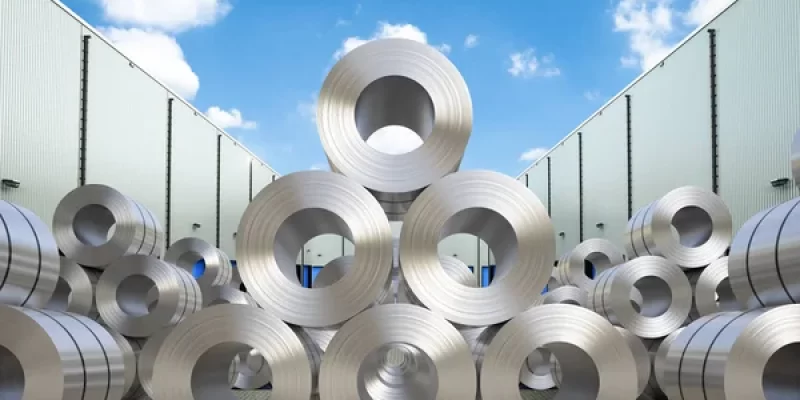Let’s Start Work
Together
Please feel free to contact us. We will get back to you with 1-2 business days. Or just call us now.
Steel Industries
Electrical steel is usually manufactured in cold-rolled strips less than 2 mm thick. These strips are cut to shape to make laminations which are stacked together to form the laminated cores of transformers, and the stator and rotor of electric motors. Laminations may be cut to their finished shape by a punch and die or, in smaller quantities, may be cut by a laser, or by wire electrical discharge machining.
Grain-oriented electrical steel usually has a silicon level of 3% (Si:11Fe). It is processed in such a way that the optimal properties are developed in the rolling direction, due to a tight control (proposed by Norman P. Goss) of the crystal orientation relative to the sheet. The magnetic flux density is increased by 30% in the coil rolling direction, although its magnetic saturation is decreased by 5%. It is used for the cores of power and distribution transformers, cold-rolled grain-oriented steel is often abbreviated to CRGO.
CRNGO is less expensive than CRGO. It is used when cost is more important than efficiency and for applications where the direction of magnetic flux is not constant, as in electric motors and generators with moving parts. It can be used when there is insufficient space to orient components to take advantage of the directional properties of grain-oriented electrical steel.
Our Solutions & Benefits
We provide Steel Sheet Testing Equipment, which is widely used in Transformer EI Lamination, Motor Stamping & Transformer Core Manufacturing Industries. We provide better solution for better quality of Testing Equipment. Our Products are robust, reliable and easy to opearte.
- CRGO/CRNO/CRC/HR Steel Sheet Manufacturing Industries
- Steel Sheet Trading, Calibration Lab
- Steel Sheet , Transformer, Motor , EV Quality Deprtment
Watt loss measurement by Epstein Bridge method using Epstein Tester.
Epstein bridge test method is a fundamental method for evaluating the magnetic performance of flat-rolled magnetic materials in either sheared or stress relief annealed condition. This test method is suitable for design, specification acceptance, service evaluation, and research and development.
Surface Insulation Resistivity of Electrical Steel Sheet.
Gopal make Franklin Tester Model FT-2 is designed as per IS:649 & ASTM:717 Standard to measure insulation resistivity of electrical steel sheet. It requires precision & noise free DC regulated power supply and equally distributed pressure on electrode. FT-2 regulated power supply provides 0.5000V with 0.1% accuracy over load and no load. Most of national and international standard has specified only 0.5%, means FT-2 is equipped with five time better accuracy than required.
Watt Loss Testing by Single Sheet Test Method.
In this Method Sensor Probe is used.
The SST 500x500 is Big Probe and it can be attached as probe to Ep400 Main unit and user can test specific total loss, specific apparent power, and r.m.s value of magnetic field strength as well as B/h curve in the software.
Another probe is Small Probe method. The Digital Single sheet iron loss tester which is useful to evaluate iron loss of electrical steel sheet CRGO, CRNO material and suitable for testing EI lamination, Motor Stamping, Fan motor stamping etc. Single sheet tester is suitable for tentative evaluation of sample, how ever for precision measurement user can go for Epstein Tester.
What is Included
CRGO Grain oriented grades of electrical steel are typically used for transformer cores and large generators. Non-oriented Electrical steel CRNGO fully processed steels are iron-silicon alloys with varying silicon contents and have similar magnetic properties in all directions in plan of the sheet.
The difference between annealing and tempering comes down to how it is treated. Annealing involves heating steel to a specified temperature and then cooling at a very slow and controlled rate, whereas tempering involves heating the metal to a precise temperature below the critical point, and is often done in air, vacuum or inert atmospheres.
Annealing involves heating steel to a specified temperature and then cooling at a very slow and controlled rate.
Annealing is commonly used to:
- Soften a metal for cold working
- Improve machinability
- Enhance electrical conductivity
Tempering is used to increase the toughness of iron alloys, particularly steel. Untempered steel is very hard but is too brittle for most applications. Tempering is commonly done after hardening to reduce excess hardness.
Tempering is used to alter:
- Hardness
- Ductility
- Toughness
- Strength
- Structural stability

